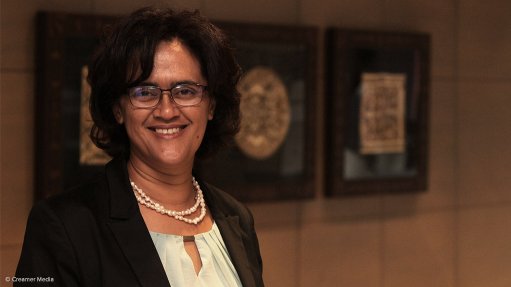
Cesa president Lynne Pretorius
Photo by: Duane Daws
A year after taking a back-to-basics approach, Consulting Engineers South Africa (Cesa) is gearing up to tackle transformation within its membership base and throughout its industry, with a transformation committee embarking on a process to develop the industry body’s proposed interventions to drive real and sustainable transformation.
The committee will, over the next few months, develop a “transformation action plan” to set in place the building blocks to unlock sustainable growth and transformation in the consulting engineering sector.
Transformation acceleration is an essential focus for the industry body, as, despite the significant strides made, the country faced the same – and some new – challenges more than 20 years after the dawn of democracy, said Cesa president Lynne Pretorius at her second presidential address on Wednesday.
“Questions are being raised about the effectiveness of the broad-based black economic empowerment (BBBEE) policies [and] the quality of education. The fees must fall campaign has forced many to recognise and acknowledge the challenges that are being faced by many students, including engineering students, at tertiary institutions,” Cesa’s first female president said at the yearly event.
“It has also become apparent this is no longer a matter of black disadvantage alone, but a matter of poverty versus privilege [with a] direct link to access to quality education.”
Within Cesa’s membership base, only 122 of the 533 firms are more than 51% black-owned, women remain in the minority, 53% of staff and 84% of professional engineers across the membership are white, and the employment breakdown indicates that black people are typically employed lower down on the professional hierarchy as technicians, technical assistants and laboratory or survey assistants.
“When it comes to transformation of the consulting engineering profession, we have to acknowledge the numbers,” she commented.
By this she meant the limited number of learners with sufficient competence in mathematics and science leaving the school system; that the engineering profession has to compete with other sectors to attract these learners to engineering degree programmes; there is limited information to track whether transformation criteria are being met; that the average age of engineering professionals is 38 years and that mentoring has become a concern; and that the number of black and female engineers is increasing in the public sector, but not necessarily in the private sector.
“Of concern is not so much the achievement of transformation goals, but the overall sustainable development of all young engineering staff towards professional registration,” Pretorius said.
Cesa’s transformation committee is working to unpack the mechanics behind transformation, promote it and monitor progress in attaining it, beyond the requirements of the Construction Sector Scorecard, including through developing registered engineering professionals through several strategies.
The group aims to develop a long-term, deeper “pipeline” to develop professionally registered engineers, starting with the identification and support of learners with the aptitude for maths and science at secondary school level, thereafter to support, financially assist, guide and mentor tertiary students towards the field of engineering.
This strategy will further see the assistance with workplace placement after graduation, and the mentoring of engineering staff in the workplace until registration as a professional engineer.
Tailored support to small and medium-sized businesses is also on the cards, with proposals tabled for the establishment of an incubator programme and a database of emerging firms tabled.
Mentoring also has a role to play in Cesa’s vision, as the number of experienced engineers dwindle. The industry body is seeking to develop mentoring programmes and partnerships with member companies, retired engineers and government departments alike to enable graduates to obtain exposure and experience.
In line with opening up more opportunities for women in the sector, one of Cesa’s strategies includes “acknowledging the glass ceiling”.
“Programmes have to be developed to, firstly, acknowledge the barriers faced by women, and within the context of transformation, gender concerns and challenges must become part of mainstream industry discussions,” Pretorius commented.
There is also a need to acknowledge and overcome barriers that inhibit the advance of previously marginalised groups aspiring to enter the engineering profession.
Monitoring will also be critical in Cesa’s transformation strategy, as the information collected from its members currently does not allow meaningful discussions on the state of transformation.
“We do have BBBEE scores, but we have expanded the annual declaration of member firms to reflect the staff demographics so that we can use that as an indicator of transformation, as the BBBEE scores are not of necessity a detailed enough indicator,” she added.
“So Cesa will embark on various programmes over the next few years to address challenging matters with respect to transformation. This will entail clearly defined transformation goals, projects and programmes, to enable successful implementation,” Pretorius concluded.